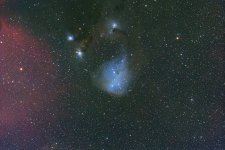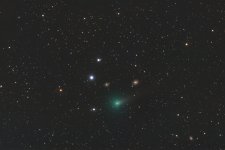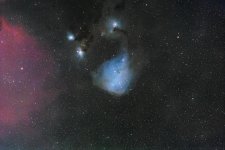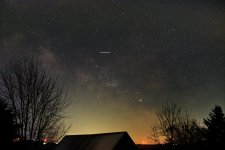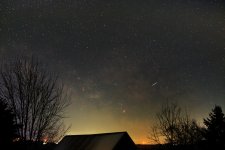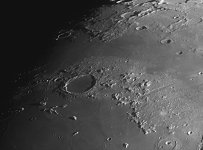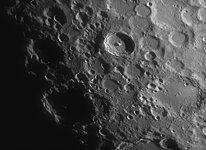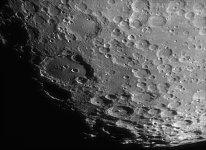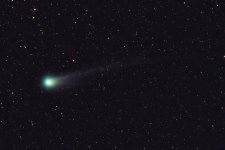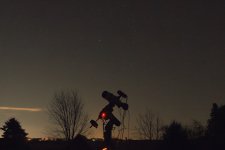Doing real Astronomy! Love to see it.My results are getting migrate up to NASA Exoplanet Watch.
You are using an out of date browser. It may not display this or other websites correctly.
You should upgrade or use an alternative browser.
You should upgrade or use an alternative browser.
Astronomy pictures thread
- Thread starter EricTheCat
- Start date
Welcome to the Precious Metals Bug Forums
Welcome to the PMBug forums - a watering hole for folks interested in gold, silver, precious metals, sound money, investing, market and economic news, central bank monetary policies, politics and more.
Why not register an account and join the discussions? When you register an account and log in, you may enjoy additional benefits including no Google ads, market data/charts, access to trade/barter with the community and much more. Registering an account is free - you have nothing to lose!
Had some fun in the sun today.
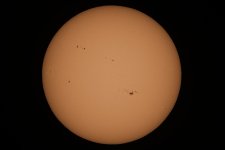
Camera: Canon Rebel T8i (modified)
Telescope: 110mm f/7 ED refractor
Filter: Baader white light filter
Exposure: 1/4000sec at ISO 200
Closeup of sunspot group 3576
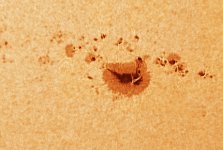
Camera: ZWO ASI678MC with Televue 2X barlow + ZWO IR cut filter
Telescope: 110mm f/7 ED refractor
Filter: Baader white light filter

Camera: Canon Rebel T8i (modified)
Telescope: 110mm f/7 ED refractor
Filter: Baader white light filter
Exposure: 1/4000sec at ISO 200
Closeup of sunspot group 3576

Camera: ZWO ASI678MC with Televue 2X barlow + ZWO IR cut filter
Telescope: 110mm f/7 ED refractor
Filter: Baader white light filter
- Messages
- 521
- Reaction score
- 758
- Points
- 268
Baader makes damn good white light filters. It looks like you can make out some of the bright calcium plage regions, in the full disc image.Had some fun in the sun today.
View attachment 11983
Camera: Canon Rebel T8i (modified)
Telescope: 110mm f/7 ED refractor
Filter: Baader white light filter
Exposure: 1/4000sec at ISO 200
Closeup of sunspot group 3576
View attachment 11984
Camera: ZWO ASI678MC with Televue 2X barlow + ZWO IR cut filter
Telescope: 110mm f/7 ED refractor
Filter: Baader white light filter
Indeed. I was surprised how much better the contrast is compared to my other solar filters. I have 2 Baader filters now. One for that scope and one for my AT92. Planning to use the AT92 for the eclipse this April for a wider view of the corona (of course, filter will be removed for totality).Baader makes damn good white light filters. It looks like you can make out some of the bright calcium plage regions, in the full disc image.
- Messages
- 18,799
- Reaction score
- 11,270
- Points
- 288
I'm sure that means something important, but what do it mean??My results are getting migrate up to NASA Exoplanet Watch.
- Messages
- 18,799
- Reaction score
- 11,270
- Points
- 288
Nice crater!Close up of Plato crater on the moon with the same setup.
Any reason one couldn't see the lander and flag on the Moon with that setup?
- Messages
- 521
- Reaction score
- 758
- Points
- 268
Interesting comet image. What exposure times were they? Do your stars streak and require special processing?Comet 62P/Tsuchinshan from this morning.
View attachment 11995
Date: 2/12/2024
Camera: Canon Rebel T8i (modified)
Telescope: 92mm f/5.5 triplet (Astrotech AT92) with focal reducer
Exposure: 50x300 (4hr 10min total) at ISO 400
Amazingly it did not require special processing. The comet did not move much at all relative to the background over 4 hours. Very convenient! I was expecting to be in for all the time that kind of processing requires. Exposure was 50x300sec (4hr 10min total) at ISO 400 at f/5.5.Interesting comet image. What exposure times were they? Do your stars streak and require special processing?
- Messages
- 521
- Reaction score
- 758
- Points
- 268
Wow that is unusual.Amazingly it did not require special processing. The comet did not move much at all relative to the background over 4 hours. Very convenient! I was expecting to be in for all the time that kind of processing requires. Exposure was 50x300sec (4hr 10min total) at ISO 400 at f/5.5.
Then I went for M100 (The Blowdryer Galaxy). Only got 3hr 20 min on that one due to clouds.
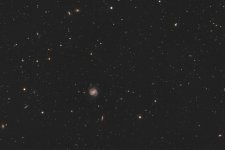
Cropped to show detail
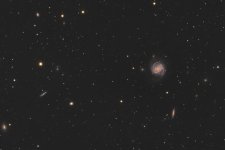
Without the stars stretched to make the galaxies stand out.
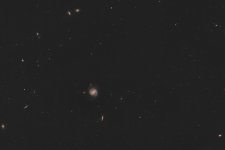
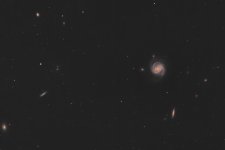
Date: 2/12/2024
Camera: Canon Rebel T8i
Telescope: 92mm f/5.5 triplet (Astrotech AT92) with focal reducer
Exposure: 40x300sec (3hr 20min total) at ISO 400

Cropped to show detail

Without the stars stretched to make the galaxies stand out.


Date: 2/12/2024
Camera: Canon Rebel T8i
Telescope: 92mm f/5.5 triplet (Astrotech AT92) with focal reducer
Exposure: 40x300sec (3hr 20min total) at ISO 400
- Messages
- 521
- Reaction score
- 758
- Points
- 268

Mars helicopter Ingenuity's final resting place named after 'Undying Lands' in 'Lord of the Rings'
There are Tolkien fans at the Jet Propulsion Lab.
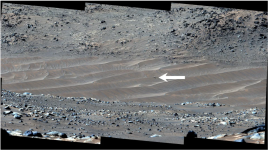
- Messages
- 521
- Reaction score
- 758
- Points
- 268
Odd question - can you capture/photo the Falcon 9 rocket that just blasted off and is headed to the moon? How does that work with exposure time and such?
Satellite Launch Direction
Most rockets hoping to achieve earth orbit are launched West -> East and from near the equator to gain maximum advantage from the spin of the Earth. I know the launches often also are deliberately
I've seen people within say 100 miles (of the launch pad) post pictures of the contrail and the vehicle before it reaches escape velocity.
Once in orbit very little or no rocket fuel (burning) is used.
Time-lapse of the space station passes:
Still working on the milky way rising time-lapse but also planning to do more solar testing today (eclipse preparation).
Still working on the milky way rising time-lapse but also planning to do more solar testing today (eclipse preparation).
- Messages
- 521
- Reaction score
- 758
- Points
- 268
Time-lapse of the space station passes:
Still working on the milky way rising time-lapse but also planning to do more solar testing today (eclipse preparation).
Very cool!
Fun with the sun today. I am really surprise how much detail I was able to pull on the new sunspot group that is just emerging with my ASI678MC+2X barlow.
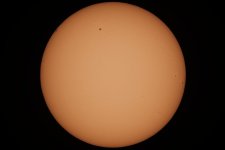
Camera: Canon Rebel T8i (modified)
Telescope: 110mm f/7 ED refractor
Filter: Baader white light filter
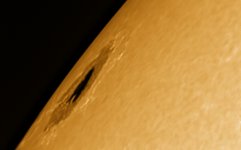
Camera: ZWO ASI678MC with Televue 2X barlow + ZWO IR cut filter
Telescope: 110mm f/7 ED refractor
Filter: Baader white light filter

Camera: Canon Rebel T8i (modified)
Telescope: 110mm f/7 ED refractor
Filter: Baader white light filter

Camera: ZWO ASI678MC with Televue 2X barlow + ZWO IR cut filter
Telescope: 110mm f/7 ED refractor
Filter: Baader white light filter
Milky way rising time-lapse from early Saturday morning.
I'm thinkin' he means the crater in the upper center portion of the 2nd pic. It has a little mountain peak right in the center of it. None of the others have that.Not sure which one you're talking about.
I know liquid can do that, as shown in your pic, but can that also happen with a large enough object hitting non-liquid?
To me it looks like a newer crater than the other big ones around it, as to my eye, they seem like they are half filled with regolith. The one in question (to me anyways) has a clean-er look to it. It looks rounder, and rocky-er. The bottoms of most of the others look flat and featureless.
As in, is it possible the others had little peaks in the centers at one time, but they are now covered with regolith scattered from newer impacts?
My understanding is central peaks in craters happens due to uplifting of material in the center of a crater caused by the explosion of the impact.
There are a couple other craters shown with central peaks in my last post. One near the top right of center in the first pic and a couple in the last pic.
The effect is also somewhat visible at the famous impact crater near Winslow, AZ. Good excuse for me to share my luckiest pic.
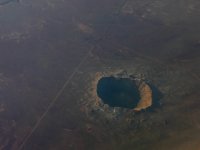
There are a couple other craters shown with central peaks in my last post. One near the top right of center in the first pic and a couple in the last pic.
The effect is also somewhat visible at the famous impact crater near Winslow, AZ. Good excuse for me to share my luckiest pic.

Another ISS solar transit fail this morning. I was almost ready to go but did not realize the power connection on my tracking mount was loose. By the time I noticed and got back into position I missed the transit by probably less than 20 seconds!
Oh well. Here's a quick and dirty pic of the sun at only 22 degrees above the horizon. Good to be testing these things ahead of the eclipse.
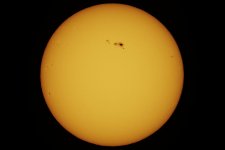
Oh well. Here's a quick and dirty pic of the sun at only 22 degrees above the horizon. Good to be testing these things ahead of the eclipse.

Last edited:
My understanding is central peaks in craters happens due to uplifting of material in the center of a crater caused by the explosion of the impact.
...
I guess it could depend upon the nature of the soil at the point of impact, but it struck me how most of the craters I see in moon pictures have very smooth interiors. The crater(s) with the center point debris really stand(s) out. Maybe it's just me not really having a good appreciation of the moon's surface, but that's why I asked the question.
I think the smooth interiors happen when the material is still melted from the impact when it settles. I would guess there is a lot that can be learned about a crater formation just by looking at it but I'm far from an expert, at anything.I guess it could depend upon the nature of the soil at the point of impact, but it struck me how most of the craters I see in moon pictures have very smooth interiors. The crater(s) with the center point debris really stand(s) out. Maybe it's just me not really having a good appreciation of the moon's surface, but that's why I asked the question.
More fun in the sun today (between clouds). Sunspot group AR3590 is so large that it is obvious just through the filter with no magnification (without using the telescope).
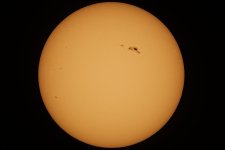
Camera: Canon Rebel T8i (modified)
Telescope: 110mm f/7 ED refractor
Filter: Baader white light filter
Exposure: 1/3200sec at ISO 100
Close up of sunspot group AR3590
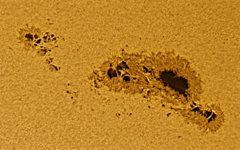
Camera: ZWO ASI678MC with Televue 2X barlow + ZWO IR cut filter
Telescope: 110mm f/7 ED refractor
Filter: Baader white light filter

Camera: Canon Rebel T8i (modified)
Telescope: 110mm f/7 ED refractor
Filter: Baader white light filter
Exposure: 1/3200sec at ISO 100
Close up of sunspot group AR3590

Camera: ZWO ASI678MC with Televue 2X barlow + ZWO IR cut filter
Telescope: 110mm f/7 ED refractor
Filter: Baader white light filter
Full Moon today...
Pull your pants up GH.
Speaking of comets, I've heard something about a comet that might be visible during the upcoming Eclipse? Any truth to that?Comet 12P/Pons-Brooks last night.
Speaking of comets, I've heard something about a comet that might be visible during the upcoming Eclipse? Any truth to that?
Yes. That is this comet 12P/Pons-Brooks. Comets are unpredictable but there is a chance it will be bright enough to be visible during totality. I plan to attempt to get a wide image with the eclipse and the comet in the same frame.
Eric do you use the ZWO ASIAIR for wireless capture?
No. Currently still using an old laptop with BackyardEOS and a long USB extension. I have begun experimenting with astroberry on a Raspberry PI 4 which I might put to use. My long term plan is to set up a relatively beefy mini PC to keep with the mount to dedicate to image acquisition.
I haven't ruled out ASIAIR but am leaning away from it.

